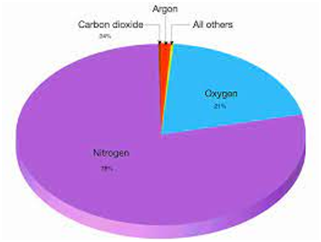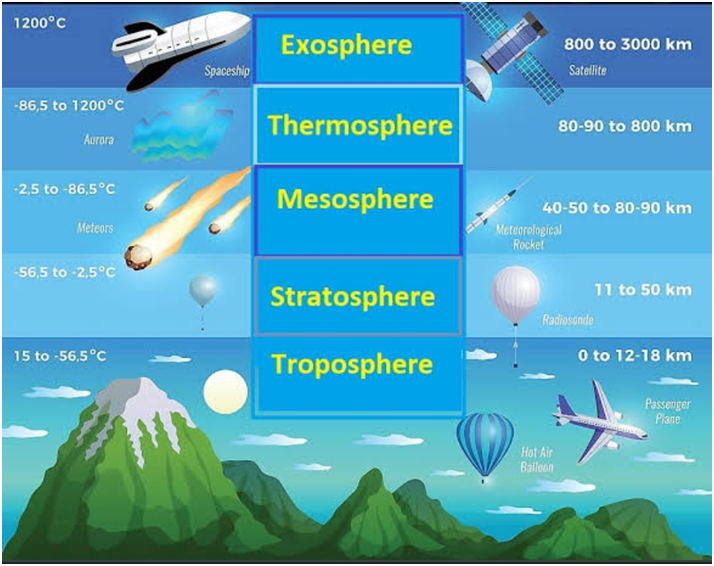- Books Name
- Social Science Book
- Publication
- Cognizance Publication
- Course
- CBSE Class 7
- Subject
- Social Science
Chapter 4
Air
Atmosphere
A huge blanket of air that surrounds earth is called atmosphere. It provides us the air we breath and protect us from the harmful effects of the sun's rays which is essential for our survival. Without this blanket of protection we would be baked away by the heat of the sun during day and get frozen during night.So it is the mass of air that has made the temperature on the earth liveable.
Composition of the atmosphere
Nitrogen and oxygen are two gases which make up the bulk of the atmosphere.Carbon dioxide, helium, ozone organ and hydrogen are found in lesser quantities.Apart from these gases, tiny dust particles are also present in the air.Percentage of different constituents of air:-
Nitrogen 78%, Oxygen 21%, Argon 0.93%, Carbon dioxide 0.03% and all other 0.04%.

Nitrogen is the most plentiful gas in the atmosphere. When we inhale, we take some amount of nitrogen into our lungs and exhale it.Plants need nitrogen for their survival. They cannot take nitrogen directly from the air.Bacteria, that live in the soil and roots of some plants, take nitrogen from the air and change its form so that plants can use it.
Oxygen is the second most plentiful gas in the air.Humans and animals take oxygen from the air as they breathe.Green plants produce oxygen during photosynthesis, which make oxygen content in the air remains constant.If we cut trees, then this balance get disturbed.
Carbon dioxide is another important gas.Green plants use carbon dioxide to make their food and release oxygen.Humans or animals release carbon dioxide. The amount of carbon dioxide released by humans or animals is equal to the amount used by the plants, which make a perfect balance.However, the balance is upset by burning of fuels such as coal and oil,add billions of tons of carbon dioxide into the atmosphere each year.Which result in increased volume of carbon dioxide affecting the earth weather and climate.Carbon dioxide released in the atmosphere creates a greenhouse effect by trapping the heat radiated from the earth. It is therefore called a greenhouse gas. And without it, the earth would have been too cold to live in.However, when it's level in the atmosphere increases due to the factory smoke or car fumes, the retained increases the temperature of the earth. This is called global warming. This rise in temperature causes the snow in the coldest part of the world to melt.
As a result, the sea level rises, causing floods in the coastal areas. There may be drastic changes in climate of a place leading to extinction of some plants and animals in the long run.
When air is heated, it expands, becomes lighter and goes up. Cold air is denser and heavy. That is why it tends to sink down . When hot air rises, cold air from surrounding area rushes there to fill in the gap. This is how the air circulation takes place.
Structure of the Atmosphere

Our atmosphere is divided into 5 layers, starting from the earth surface. These are.Troposphere,Stratosphere, Mesosphere, Thermosphere, Exosphere.
Troposphere
It is the most important layer as the air we breathe existshere and almost all the weather phenomena like rainfall, fog and hailstorm occur in this layer.Its average height is 13 km.
Stratosphere
It lies above the troposphere.It extends upto the height of 50 km.This layer is almost free from clouds and associated weather phenomena, making conditions most ideal for flying aeroplanes. One most important feature of this layer is that it contains a layer of ozone gas which protect us from harmful effect of sun rays.
Mesosphere
This is the third layer of the atmosphere, which lies above the stratosphere.It extends upto the height of 80 km.Meteorites burn up in this layer on entering from the space.
Thermosphere
Temperature rises very rapidly with increasing height in this layer.Ionosphere is a part of this layer. It extends between 80-400 km. This layer helps in radio transmission.Radio wave transmitted from the earth are reflected back to the Earth by this layer.
Exosphere
The uppermost layer of the atmosphere is known as exosphere.This layer has very thin air.Light gases like helium and hydrogen float into the space from here.

 Cognizance Publication
Cognizance Publication
